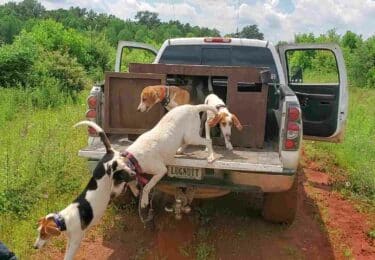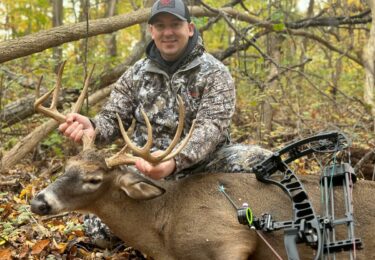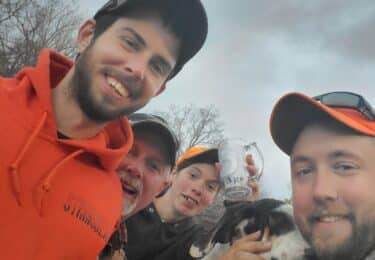By Brian Halchak
As I’ve gotten older, I have become more and more interested in learning in-depth knowledge about the wildlife I hunt and the wild places where I hunt them. I’ve also gotten intrigued with the people of the past who ventured off into the unknown as I do to chase these animals and see these places. With that, I thought that it would be a good idea to share the books that I felt have given me an edge while out hunting as well as the ones that have helped me learn how hunting has progressed throughout American history. Another benefit to the list I will provide below, is that the more knowledgeable a hunter is, the better we can speak to our non-hunting friends about what we do, why it’s important, and explain how we feel (yes, feel) about the entire process.
Hunting has been imbedded in us all since we evolved into modern day humans and conveying the message of what we do is more important than ever. My hope is that sharing these books with you all will help us all become more educated and will help us all speak more intellectually about the animals we hunt, why we hunt them, and how the whole process is critical to the entire life cycle of our being. Being an advocate for our hobby, passion, profession, etc. is only going to help us all in the long run. This list is just a start, and maybe we can start a book trading program within our group. Education is key, and I’ve found that people understand what I do much better when I can speak to them intellectually and honestly about hunting and the wildlife that I hunt.
Some of these books also include topics that may go against some of our thinking. It is imperative that we also educate ourselves on the ideas and morals of those who do not think like us. We are in a time where we are easily isolated from provoking thoughts, and without listening and understanding our “opponents”, we will never be able to understand where they are coming from nor how to challenge key issues in the hunting space. It is also important to challenge ourselves and our own thinking from time to time so that we can learn and grow ourselves. Polarizing thought in like minded groups is diminishing our ability to have thoughtful debate, and I feel it is just as important to educate myself on what others think, feel, and understand from a scientific standpoint as it is to study material that confirms my thoughts and understanding of the world.
Wildlife Education
- Coyote America: Dan Flores
Legends don’t come close to capturing the incredible story of the coyote. In the face of centuries of campaigns of annihilation employing gases, helicopters, and engineered epidemics, coyotes didn’t just survive, they thrived, expanding across the continent from Alaska to New York. In the war between humans and coyotes, coyotes have won, hands-down. Coyote America is the illuminating five-million-year biography of this extraordinary animal, from its origins to its apotheosis. It is one of the great epics of our time. - Animal Weapons: Douglas J. Emlen
In Animal Weapons, Doug Emlen takes us outside the lab and deep into the forests and jungles, to explain the processes behind the most intriguing and curious examples of extreme animal weapons-fish with mouths larger than their bodies and bugs whose heads are so packed with muscle they don’t have room for eyes. As singular and strange as some of the weapons are, we learn that similar factors set their evolution in motion. He looks at everything from our armor and camouflage to the evolution of the rifle and the structures human populations have built across different regions and eras to protect their homes and communities. Animal Weapons brings us the complete story of how weapons reach their most outsized, dramatic potential, and what the results we witness in the animal world can tell us about our own relationship with weapons of all kinds. - Path of the Puma: Jim Williams
During a time when most wild animals are experiencing decline in the face of development and climate change, the intrepid mountain lion – also known as a puma, a cougar, and by many other names – has experienced reinvigoration as well as expansion of territory. What makes this cat, the fourth carnivore in the food chain – just ahead of humans – so resilient and resourceful? And what can conservationists and wildlife managers learn from them about the web of biodiversity that is in desperate need of protection? Their story is fascinating for the lessons it can afford the protection of all species in times of dire challenge and decline.
Hunting Stories & Wild Places
- Afield: American Writers on Bird Dogs
This marvelous collection features stories from some of America’s finest and most respected writers about every outdoorsman’s favorite and most loyal hunting partner: his dog. For the first time, the stories of acclaimed writers such as Richard Ford, Tom Brokaw, Howell Raines, Rick Bass, Sydney Lea, Jim Harrison, Tom McGuane, Phil Caputo, and Chris Camuto come together in one collection. Hunters and non-hunters alike will recognize in these poignant tales the universal aspects of owning dogs: companionship, triumph, joy, forgiveness, and loss. - The Fragrance of Grass: Guy de la Valdene
An ode to one man’s enduring love affair with hunting, The Fragrance of Grass stands as a testament to Guy de la Valdene’s deep affection for and abiding respect of the natural work and all its inhabitants. Set in places as far afield as France and Montana, Saskatchewan and Florida, this beautifully written memoir is a treatise on dogs, birds, and wildlife; food, wine, and women. - For a Handful of Feathers: Guy de la Valdene
A lifelong hunter and wild-game gourmet who has traveled the globe on expeditions with world-class sportsmen, Guy de la Valdéne purchased an 800-acre farm outside Tallahassee and set out to raise and hunt his favorite game bird, bobwhite quail. But de la Valdéne is also a naturalist at heart, and as he planted trees and divided fields, he found that running the farm compelled him to operate as both hunter and preservationist, predator and protector. De la Valdéne structures his reflections around a year in the life cycle of the bobwhite quail, from one generation’s birth through mating and the raising of their young. Along the way, he gets pulled along on some side trips: to a masterpiece of controlled burning performed by a Vietnam veteran in a helicopter with 300 gallons of napalm, and to his own adventures when he improvises some dam-raising to fill his pond. For a Handful of Feathers reconciles a passion for hunting with a deep sentiment for the wild. - A Sand County Almanac: Aldo Leopold
First published in 1949 and praised in the New York Times Book Review as “full of beauty and vigor and bite”, A Sand County Almanac combines some of the finest nature writing since Thoreau with an outspoken and highly ethical regard for America’s relationship to the land. As the forerunner to such important books as Annie Dillard’s Pilgrim at Tinker Creek, Edward Abbey’s Desert Solitaire, and Robert Finch’s The Primal Place, this classic work remains as relevant today as it was more than 70 years ago. - A Hunter’s Heart: Honest Essays on Blood Sport
Without apology, the voices in A Hunter’s Heart speak of the verities of the hunt, our connections to the land, and the ethics of blood sport, with essays by the best writers in the field. - Meat Eater, Adventures from the Life of an American Hunter: Steven Rinella
A thrilling storyteller with boundless interesting facts and historical information about the land, the natural world, and the history of hunting, Rinella also includes after each chapter a section of “Tasting Notes” that draws from his thirty-plus years of eating and cooking wild game, both at home and over a campfire. In Meat Eater he paints a loving portrait of a way of life that is part of who we are as humans and as Americans. - The Green Swamp Journal: Russell McCoy
“Ever since I was a small boy, I have been fascinated and curious about the ‘great outdoors.’ Every day spent in the woods has been a new adventure, often with surprises. Here in the Green Swamp Journal, I wish to share some of my most memorable days afield and relate some of Green Swamp’s ‘history and mystery.'” As a check station operator for the Florida FWC I developed an interest in Green Swamp’s history and I met many people who’d spent their lives in the area. Much of their knowledge, some passed down from preceeding generations, was shared and combined with my own research and experiences, and now I am able to relay some of the information in The Green Swamp Journal. The Green Swamp is a wildlife management area in West-Central Florida rich in history and wildlife from the earliest of times. Hunting, Camping, Fishing, and Eco-Tourism are all activities enjoyed in this area. Come along and enjoy the great outdoors again in the memoir, The Green Swamp Journal. - Annals of the Former World: John McPhee
Twenty years ago, when John McPhee began his journeys back and forth across the United States, he planned to describe a cross section of North America at about the fortieth parallel and, in the process, come to an understanding not only of the science but of the style of the geologists he traveled with. The structure of the book never changed, but its breadth caused him to complete it in stages, under the overall title Annals of the Former World. Like the terrain it covers, Annals of the Former World tells a multilayered tale, and the reader may choose one of many paths through it. As clearly and succinctly written as it is profoundly informed, this is our finest popular survey of geology and a masterpiece of modern nonfiction. - All the Wild That Remains: David Gessner
Archetypal wild man Edward Abbey and proper, dedicated Wallace Stegner left their footprints all over the western landscape. Now, the award-winning nature writer David Gessner follows the ghosts of these two remarkable writer-environmentalists – from Stegner’s birthplace in Saskatchewan to the site of Abbey’s pilgrimages to Arches – braiding their stories and asking how they speak to the lives of all those who care about the West. What is the future of a region beset by droughts and fires, by fracking and drilling? What should be done about an ever-increasing population that seems to be in the process of loving the West to death? How might two environmental thinkers with radically different personalities – a competent, mature advocate (Stegner) and a monkey-wrenching anarchist (Abbey) – have responded to the crisis?
Influential Hunters & History of the West
- Mountain Man: David Weston Marshall
In 1804, John Colter set out with Meriwether Lewis and William Clark on the first US expedition to traverse the North American continent. During the 28-month ordeal, Colter served as a hunter and scout, and honed his survival skills on the western frontier. But when the journey was over, Colter stayed behind. He spent two more years trekking alone through dangerous and unfamiliar territory, charting some of the West’s most treasured landmarks. - Cowboys, Mountain Men, and Grizzly Bears: Matthew P. Mayo
The romance of the West is built on an endless armature of shootouts and train robberies, cowboys versus Indians, white hat versus black, and everybody versus the wilderness. From John Colter’s harrowing escape from the Blackfeet to Hugh Glass’ six-week crawl to civilization after a grizzly attack, from Custer’s final moments to John Wesley Powell’s treacherous run through the rapids of the Grand Canyon, Cowboys, Mountain Men, and Grizzly Bears takes the top 50 wildest episodes in the region’s history and presents them to the listener in one convenient, narrative-driven package. - Boone: Robert Morgan
The story of Daniel Boone is the story of America—its ideals, its promise, its romance, and its destiny. Bestselling, critically acclaimed author Robert Morgan reveals the complex character of a frontiersman whose heroic life was far stranger and more fascinating than the myths that surround him. This rich, authoritative biography offers a wholly new perspective on a man who has been an American icon for more than two hundred years—a hero as important to American history as his more political contemporaries George Washington and Benjamin Franklin. Extensive endnotes, cultural and historical background material, and maps and illustrations underscore the scope of this distinguished and immensely entertaining work. - Desu The Trapper: V.K. Arsen’ev
Arseniev describes three explorations in the Ussurian taiga along the Sea of Japan above Vladivostok, beginning with his first encounter of the solitary aboriginal hunter named Dersu, a member of the Gold tribe, who thereafter becomes his guide. Each expedition is beset with hardship and danger: through blizzard and flood and assorted deprivations, these two men forge an exceptional friendship in their mutual respect for the immense grandeur of the wilderness. But the bridges across language, race and culture also have limitations, and the incursion of civilization exacts its toll. Dersu the Trapper is at once a witnessing of Russia’s last frontier and a poignant memoir of rare cross-cultural understanding. Originally published in 1941, this English translation is reprinted in its entirety now for the first time.
Shooting & Ballistics
- Applied Ballistics for Long Range Shooting: Brian Litz
Exterior ballistics is a very mature science. Unfortunately, most shooters have not been able to take full advantage of this field of knowledge because it’s always been described in a highly technical language. In this book, author, champion shooter and Ballistician Bryan Litz breaks down the complex science of accuracy into layman’s terms that are easy to understand and apply. The objective of each subject matter is to present information to the reader which they can use to hit targets at long range. New for this Third Edition The traditional role of exterior ballistics has been to account for the variables related to bullet flight so accurate fire solutions can be computed. Author Bryan Litz believes that ballistics has more to offer. - Accuracy & Precision for Long Range Shooting: Brian Litz
There’s a lot of good information available on long range shooting which explains how to correct trajectories for drop, wind deflection, etc. This book takes it a step further and discusses how various uncertainties affect your hit percentage. Weapon Employment Zone (WEZ) analysis is a method for showing how effective a weapon system is throughout its range of employment in terms of hit percentage. WEZ analysis is explained, and applied throughout the book to show how effectiveness can be improved thru various means. Accuracy and Precision for Long Range Shooting is written in the same easy to understand language that made Applied Ballistics for Long Range Shooting such an enjoyable and effective book. Long range shooting can be very technical. However, author Bryan Litz, communicates these complex ideas in layman terms, so most average shooters can master the subject with little difficulty.
Please reach out if you would like a copy of these books. I have hard copies of most of them, but most of these are also available by Kindle or Audiobook. Links will be provided as well.


